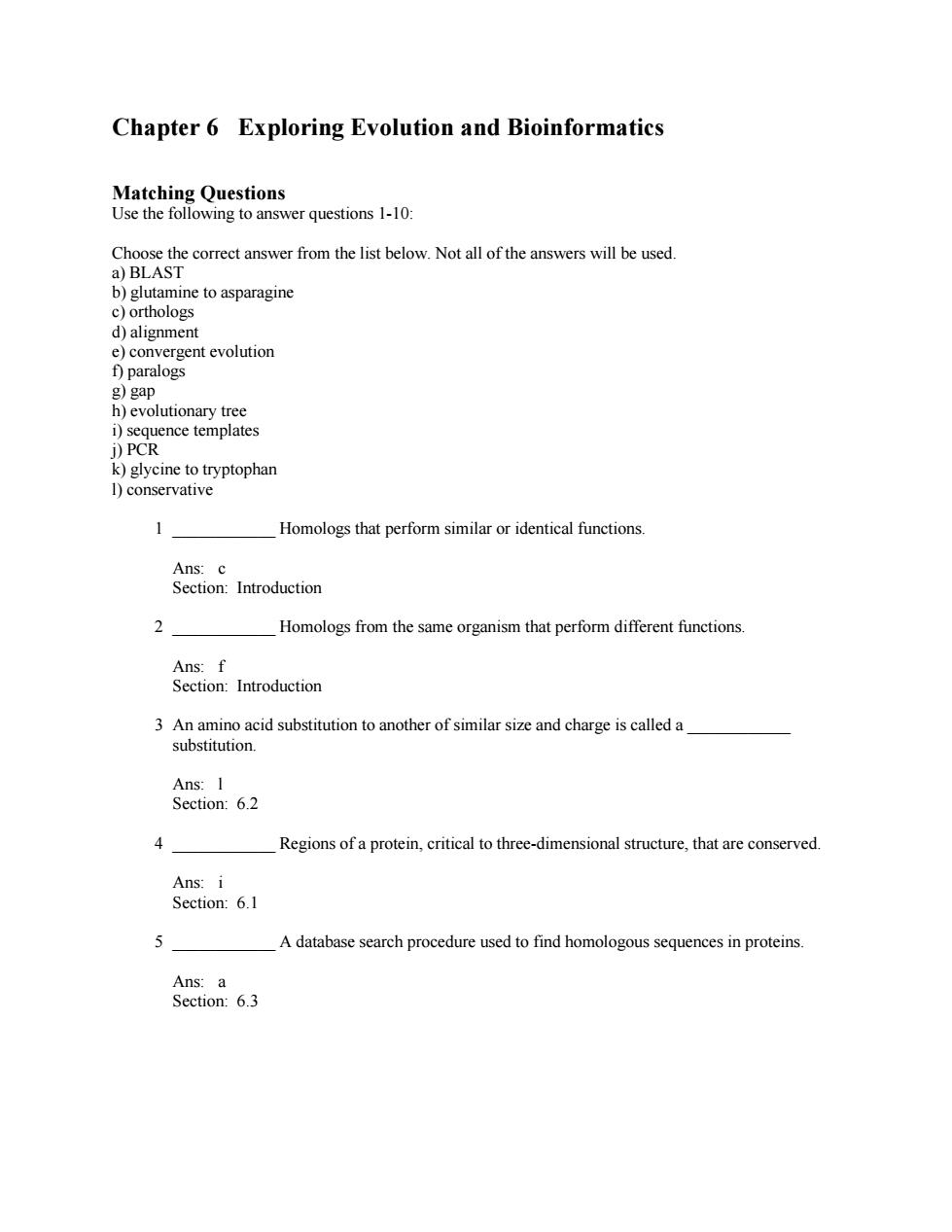
Chapter 6 Exploring Evolution and Bioinformatics Matching Questions Use the following to answer questions 1-10: Choose the correct answer from the list below.Not all of the answers will be used a)BLAST b)glutamine to asparagine c)orthologs d)alignment e)convergent evolution f)paralogs g)gap h)evolutionary tree i)sequence templates j)PCR k)glycine to tryptophan 1)conservative Homologs that perform similar or identical functions. Ans:c Section:Introduction 2 Homologs from the same organism that perform different functions. Ans:f Section:Introduction 3 An amino acid substitution to another of similar size and charge is called a substitution. Ans:I Section:6.2 4 Regions of a protein,critical to three-dimensional structure,that are conserved. Ans:i Section:6.1 5 A database search procedure used to find homologous sequences in proteins. Ans:a Section:6.3
Chapter 6 Exploring Evolution and Bioinformatics Matching Questions Use the following to answer questions 1-10: Choose the correct answer from the list below. Not all of the answers will be used. a) BLAST b) glutamine to asparagine c) orthologs d) alignment e) convergent evolution f) paralogs g) gap h) evolutionary tree i) sequence templates j) PCR k) glycine to tryptophan l) conservative 1 ____________ Homologs that perform similar or identical functions. Ans: c Section: Introduction 2 ____________ Homologs from the same organism that perform different functions. Ans: f Section: Introduction 3 An amino acid substitution to another of similar size and charge is called a ____________ substitution. Ans: l Section: 6.2 4 ____________ Regions of a protein, critical to three-dimensional structure, that are conserved. Ans: i Section: 6.1 5 ____________ A database search procedure used to find homologous sequences in proteins. Ans: a Section: 6.3
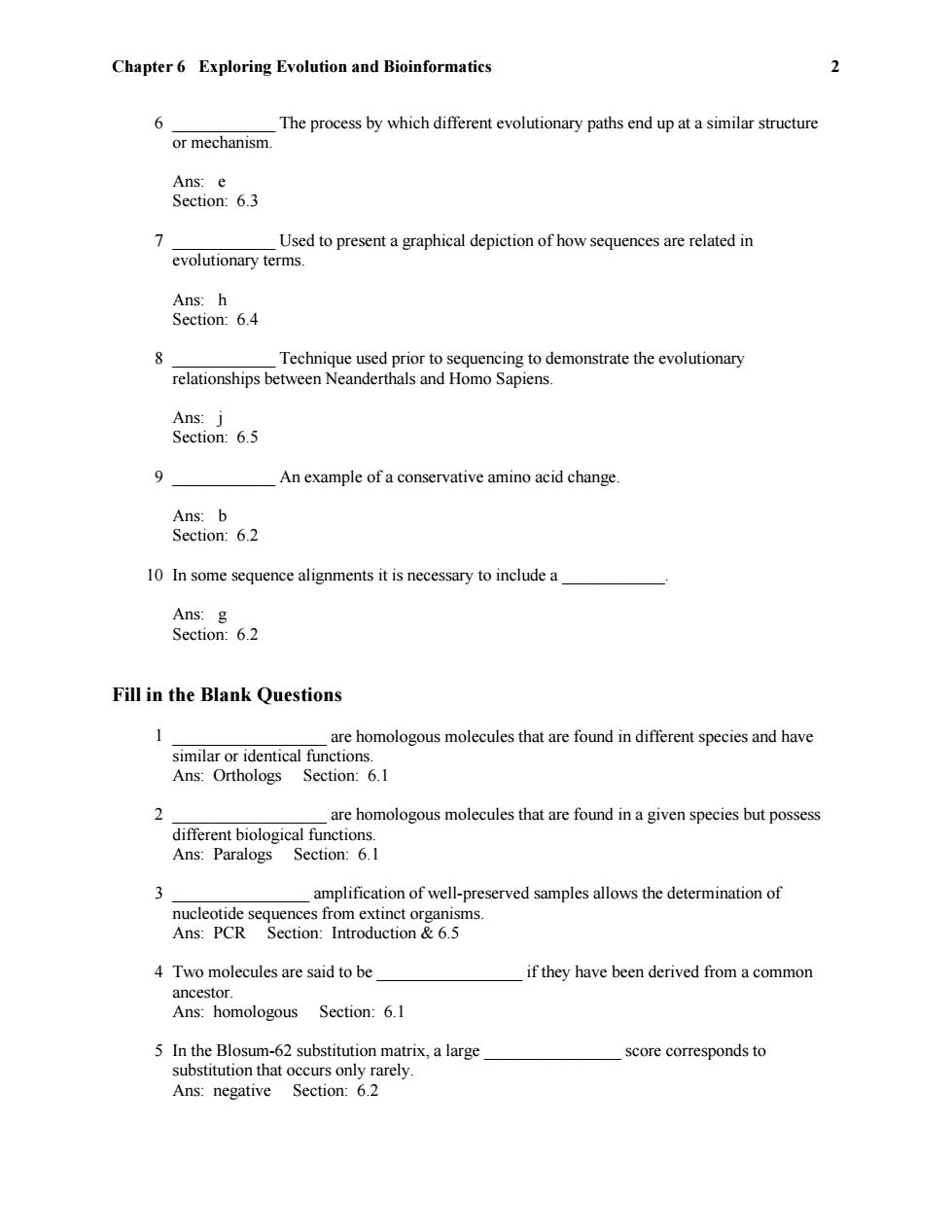
Chapter 6 Exploring Evolution and Bioinformatics 2 6 The process by which different evolutionary paths end up at a similar structure or mechanism. Ans:e Section:6.3 Used to present a graphical depiction of how sequences are related in evolutionary terms. Ans:h Section:6.4 P Technique used prior to sequencing to demonstrate the evolutionary relationships between Neanderthals and Homo Sapiens. Ans:j Section:6.5 9 An example of a conservative amino acid change. Ans:b Section:6.2 10 In some sequence alignments it is necessary to include a Ans:g Section:6.2 Fill in the Blank Questions are homologous molecules that are found in different species and have similar or identical functions. Ans:Orthologs Section:6.1 2 are homologous molecules that are found in a given species but possess different biological functions. Ans:Paralogs Section:6.1 amplification of well-preserved samples allows the determination of nucleotide sequences from extinct organisms. Ans:PCR Section:Introduction 6.5 4 Two molecules are said to be if they have been derived from a common ancestor Ans:homologous Section:6.1 5 In the Blosum-62 substitution matrix,a large score corresponds to substitution that occurs only rarely. Ans:negative Section:6.2
Chapter 6 Exploring Evolution and Bioinformatics 2 6 ____________ The process by which different evolutionary paths end up at a similar structure or mechanism. Ans: e Section: 6.3 7 ____________ Used to present a graphical depiction of how sequences are related in evolutionary terms. Ans: h Section: 6.4 8 ____________ Technique used prior to sequencing to demonstrate the evolutionary relationships between Neanderthals and Homo Sapiens. Ans: j Section: 6.5 9 ____________ An example of a conservative amino acid change. Ans: b Section: 6.2 10 In some sequence alignments it is necessary to include a ____________. Ans: g Section: 6.2 Fill in the Blank Questions 1 __________________ are homologous molecules that are found in different species and have similar or identical functions. Ans: Orthologs Section: 6.1 2 __________________ are homologous molecules that are found in a given species but possess different biological functions. Ans: Paralogs Section: 6.1 3 ________________ amplification of well-preserved samples allows the determination of nucleotide sequences from extinct organisms. Ans: PCR Section: Introduction & 6.5 4 Two molecules are said to be _________________ if they have been derived from a common ancestor. Ans: homologous Section: 6.1 5 In the Blosum-62 substitution matrix, a large ________________ score corresponds to substitution that occurs only rarely. Ans: negative Section: 6.2
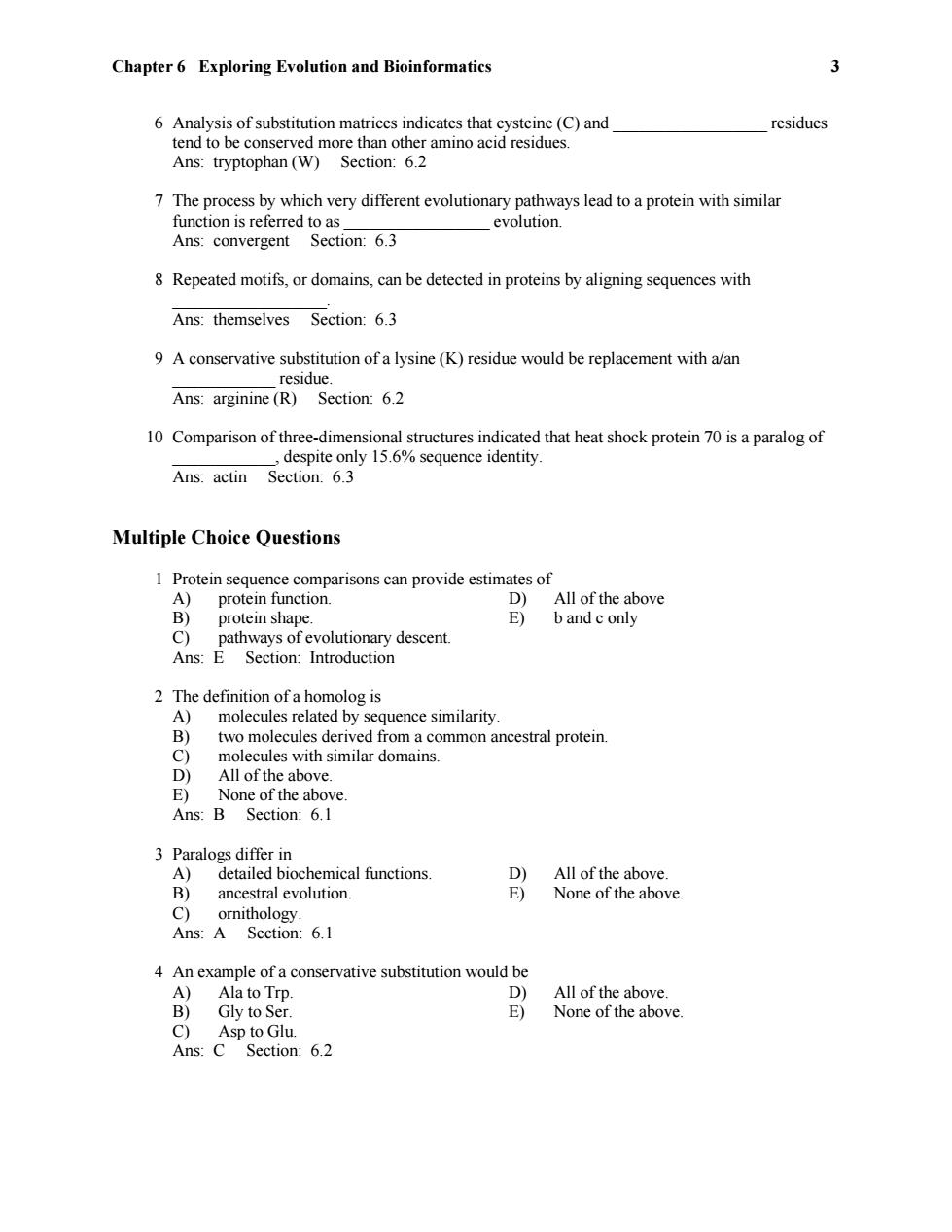
Chapter 6 Exploring Evolution and Bioinformatics w 6 Analysis of substitution matrices indicates that cysteine(C)and residues tend to be conserved more than other amino acid residues. Ans:tryptophan (W)Section:6.2 7 The process by which very different evolutionary pathways lead to a protein with similar function is referred to as evolution. Ans:convergent Section:6.3 8 Repeated motifs,or domains,can be detected in proteins by aligning sequences with Ans:themselves Section:6.3 9 A conservative substitution of a lysine(K)residue would be replacement with a/an residue. Ans:arginine(R)Section:6.2 10 Comparison of three-dimensional structures indicated that heat shock protein 70 is a paralog of despite only 15.6%sequence identity. Ans:actin Section:6.3 Multiple Choice Questions 1 Protein sequence comparisons can provide estimates of A) protein function. D All of the above B) protein shape. E) b and c only C) pathways of evolutionary descent. Ans:E Section:Introduction 2 The definition of a homolog is A) molecules related by sequence similarity. B) two molecules derived from a common ancestral protein. C) molecules with similar domains. D) All of the above. E) None of the above. Ans:B Section:6.1 3 Paralogs differ in A)detailed biochemical functions. D) All of the above. B) ancestral evolution. E) None of the above. C)ornithology. Ans:A Section:6.1 4 An example of a conservative substitution would be A)Ala to Trp D) All of the above B)Gly to Ser. E) None of the above. C)Asp to Glu. Ans:C Section:6.2
Chapter 6 Exploring Evolution and Bioinformatics 3 6 Analysis of substitution matrices indicates that cysteine (C) and __________________ residues tend to be conserved more than other amino acid residues. Ans: tryptophan (W) Section: 6.2 7 The process by which very different evolutionary pathways lead to a protein with similar function is referred to as _________________ evolution. Ans: convergent Section: 6.3 8 Repeated motifs, or domains, can be detected in proteins by aligning sequences with __________________. Ans: themselves Section: 6.3 9 A conservative substitution of a lysine (K) residue would be replacement with a/an ____________ residue. Ans: arginine (R) Section: 6.2 10 Comparison of three-dimensional structures indicated that heat shock protein 70 is a paralog of ____________, despite only 15.6% sequence identity. Ans: actin Section: 6.3 Multiple Choice Questions 1 Protein sequence comparisons can provide estimates of A) protein function. D) All of the above B) protein shape. E) b and c only C) pathways of evolutionary descent. Ans: E Section: Introduction 2 The definition of a homolog is A) molecules related by sequence similarity. B) two molecules derived from a common ancestral protein. C) molecules with similar domains. D) All of the above. E) None of the above. Ans: B Section: 6.1 3 Paralogs differ in A) detailed biochemical functions. D) All of the above. B) ancestral evolution. E) None of the above. C) ornithology. Ans: A Section: 6.1 4 An example of a conservative substitution would be A) Ala to Trp. D) All of the above. B) Gly to Ser. E) None of the above. C) Asp to Glu. Ans: C Section: 6.2
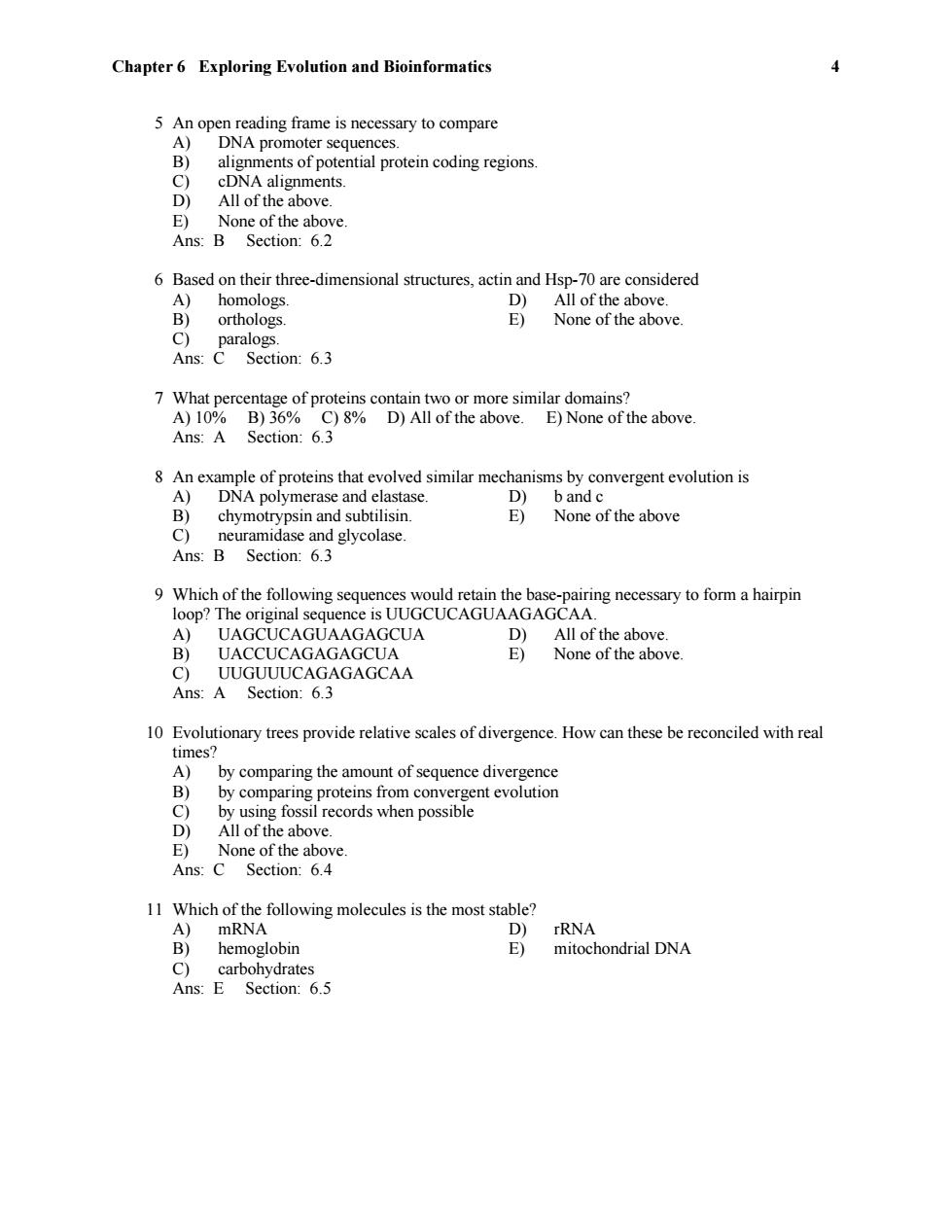
Chapter 6 Exploring Evolution and Bioinformatics 4 5 An open reading frame is necessary to compare A) DNA promoter sequences. B) alignments of potential protein coding regions. c) cDNA alignments. D All of the above. E) None of the above Ans:B Section:6.2 6 Based on their three-dimensional structures,actin and Hsp-70 are considered A)homologs D)All of the above. B) orthologs E) None of the above. C) paralogs. Ans:C Section:6.3 7 What percentage of proteins contain two or more similar domains? A)10%B)36%C)8%D)All of the above.E)None of the above. Ans:A Section:6.3 8 An example of proteins that evolved similar mechanisms by convergent evolution is A)DNA polymerase and elastase. D) b and c B) chymotrypsin and subtilisin. E) None of the above C) neuramidase and glycolase. Ans:B Section:6.3 9 Which of the following sequences would retain the base-pairing necessary to form a hairpin loop?The original sequence is UUGCUCAGUAAGAGCAA. A) UAGCUCAGUAAGAGCUA D) All of the above. B) UACCUCAGAGAGCUA E) None of the above. C)UUGUUUCAGAGAGCAA Ans:A Section:6.3 10 Evolutionary trees provide relative scales of divergence.How can these be reconciled with real times? A)by comparing the amount of sequence divergence B)by comparing proteins from convergent evolution C) by using fossil records when possible D)All of the above. E)None of the above. Ans:C Section:6.4 11 Which of the following molecules is the most stable? A)mRNA D) IRNA B)hemoglobin E) mitochondrial DNA C)carbohydrates Ans:E Section:6.5
Chapter 6 Exploring Evolution and Bioinformatics 4 5 An open reading frame is necessary to compare A) DNA promoter sequences. B) alignments of potential protein coding regions. C) cDNA alignments. D) All of the above. E) None of the above. Ans: B Section: 6.2 6 Based on their three-dimensional structures, actin and Hsp-70 are considered A) homologs. D) All of the above. B) orthologs. E) None of the above. C) paralogs. Ans: C Section: 6.3 7 What percentage of proteins contain two or more similar domains? A) 10% B) 36% C) 8% D) All of the above. E) None of the above. Ans: A Section: 6.3 8 An example of proteins that evolved similar mechanisms by convergent evolution is A) DNA polymerase and elastase. D) b and c B) chymotrypsin and subtilisin. E) None of the above C) neuramidase and glycolase. Ans: B Section: 6.3 9 Which of the following sequences would retain the base-pairing necessary to form a hairpin loop? The original sequence is UUGCUCAGUAAGAGCAA. A) UAGCUCAGUAAGAGCUA D) All of the above. B) UACCUCAGAGAGCUA E) None of the above. C) UUGUUUCAGAGAGCAA Ans: A Section: 6.3 10 Evolutionary trees provide relative scales of divergence. How can these be reconciled with real times? A) by comparing the amount of sequence divergence B) by comparing proteins from convergent evolution C) by using fossil records when possible D) All of the above. E) None of the above. Ans: C Section: 6.4 11 Which of the following molecules is the most stable? A) mRNA D) rRNA B) hemoglobin E) mitochondrial DNA C) carbohydrates Ans: E Section: 6.5
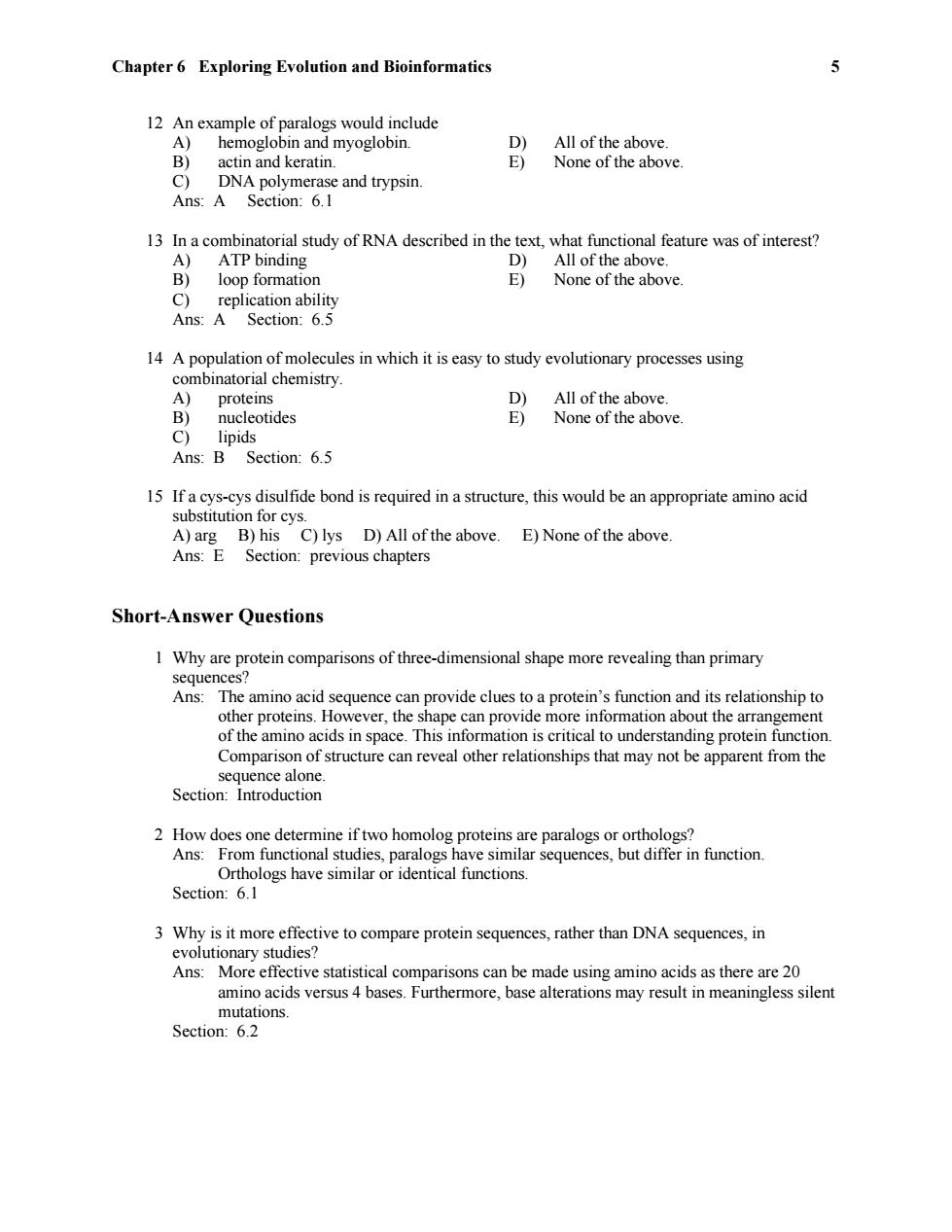
Chapter 6 Exploring Evolution and Bioinformatics 12 An example of paralogs would include A) hemoglobin and myoglobin. D) All of the above. B) actin and keratin. E) None of the above. c) DNA polymerase and trypsin. Ans:A Section:6.1 13 In a combinatorial study of RNA described in the text,what functional feature was of interest? A) ATP binding D) All of the above. B) loop formation E) None of the above. C)replication ability Ans:A Section:6.5 14 A population of molecules in which it is easy to study evolutionary processes using combinatorial chemistry. A)proteins D) All of the above. B) nucleotides E) None of the above. C)lipids Ans:B Section:6.5 15 If a cys-cys disulfide bond is required in a structure,this would be an appropriate amino acid substitution for cys. A)arg B)his C)lys D)All of the above. E)None of the above Ans:E Section:previous chapters Short-Answer Questions 1 Why are protein comparisons of three-dimensional shape more revealing than primary sequences? Ans:The amino acid sequence can provide clues to a protein's function and its relationship to other proteins.However,the shape can provide more information about the arrangement of the amino acids in space.This information is critical to understanding protein function Comparison of structure can reveal other relationships that may not be apparent from the sequence alone. Section:Introduction 2 How does one determine if two homolog proteins are paralogs or orthologs? Ans:From functional studies,paralogs have similar sequences,but differ in function. Orthologs have similar or identical functions. Section:6.1 3 Why is it more effective to compare protein sequences,rather than DNA sequences,in evolutionary studies? Ans:More effective statistical comparisons can be made using amino acids as there are 20 amino acids versus 4 bases.Furthermore,base alterations may result in meaningless silent mutations. Section:6.2
Chapter 6 Exploring Evolution and Bioinformatics 5 12 An example of paralogs would include A) hemoglobin and myoglobin. D) All of the above. B) actin and keratin. E) None of the above. C) DNA polymerase and trypsin. Ans: A Section: 6.1 13 In a combinatorial study of RNA described in the text, what functional feature was of interest? A) ATP binding D) All of the above. B) loop formation E) None of the above. C) replication ability Ans: A Section: 6.5 14 A population of molecules in which it is easy to study evolutionary processes using combinatorial chemistry. A) proteins D) All of the above. B) nucleotides E) None of the above. C) lipids Ans: B Section: 6.5 15 If a cys-cys disulfide bond is required in a structure, this would be an appropriate amino acid substitution for cys. A) arg B) his C) lys D) All of the above. E) None of the above. Ans: E Section: previous chapters Short-Answer Questions 1 Why are protein comparisons of three-dimensional shape more revealing than primary sequences? Ans: The amino acid sequence can provide clues to a protein’s function and its relationship to other proteins. However, the shape can provide more information about the arrangement of the amino acids in space. This information is critical to understanding protein function. Comparison of structure can reveal other relationships that may not be apparent from the sequence alone. Section: Introduction 2 How does one determine if two homolog proteins are paralogs or orthologs? Ans: From functional studies, paralogs have similar sequences, but differ in function. Orthologs have similar or identical functions. Section: 6.1 3 Why is it more effective to compare protein sequences, rather than DNA sequences, in evolutionary studies? Ans: More effective statistical comparisons can be made using amino acids as there are 20 amino acids versus 4 bases. Furthermore, base alterations may result in meaningless silent mutations. Section: 6.2

Chapter 6 Exploring Evolution and Bioinformatics 6 4 How are sequence alignments made? Ans:Two sequences are aligned and the best matches determined for all possible juxtapositions.In some cases,gaps are introduced to maximize the number of possible matches.Statistical formulas are used to determine the best fit according to defined parameters. Section:6.2 5 What is a substitution matrix? Ans:A substitution matrix is deduced from aligned sequences,and scores correlate to how often an amino acid is substituted. Section:6.2 6 What is the difference between a simple scoring system for alignment and the Blosum-62 matrix? Ans:The Blosum-62 allows an examination of substitutions that considers mutations that are conservative.Thus,conservative substitutions can be considered in the scoring used to determine the significance of the change in the alignment and allow more significant conclusions about evolutionary relationships. Section:6.2 7 How are three-dimensional structures useful in evolutionary comparisons? Ans:The structural details can be correlated with specific functions.Enough of the structure must be maintained to retain the function,thus sequence changes occur that do not disrupt the structure.It is difficult to determine which amino acids are critical to the structure without evaluation of the three-dimensional structure.Thus,comparisons of proteins with similar structures reveal more critical information than sequence alignments. Section:6.3 8 If a protein contains a repetitive region,what might be assumed,and what should be done next to test the hypothesis? Ans:Similar sequences imply a gene duplication event,which may indicate that that region of the protein has an important functional or structural role.The next steps would be to determine if the region of repetition is statistically significant and to examine the three- dimensional structure of the region. Section:6.3 9 In addition to examining the base sequence,what other features of RNA are useful in determining evolutionary patterns? Ans:Changes to bases that retain the ability to form base-pairs with partner bases in other sections of the sequence imply that the base pair is important.These conservative changes will retain the three-dimensional shape of the RNA molecule Section:6.3 10 What evidence exists for a duplication event that led to the a and B hemoglobin? Ans:Lamprey is a fish that diverged from bony fish long ago.It has hemoglobin that contains a single type of subunit. Section:6.4
Chapter 6 Exploring Evolution and Bioinformatics 6 4 How are sequence alignments made? Ans: Two sequences are aligned and the best matches determined for all possible juxtapositions. In some cases, gaps are introduced to maximize the number of possible matches. Statistical formulas are used to determine the best fit according to defined parameters. Section: 6.2 5 What is a substitution matrix? Ans: A substitution matrix is deduced from aligned sequences, and scores correlate to how often an amino acid is substituted. Section: 6.2 6 What is the difference between a simple scoring system for alignment and the Blosum-62 matrix? Ans: The Blosum-62 allows an examination of substitutions that considers mutations that are conservative. Thus, conservative substitutions can be considered in the scoring used to determine the significance of the change in the alignment and allow more significant conclusions about evolutionary relationships. Section: 6.2 7 How are three-dimensional structures useful in evolutionary comparisons? Ans: The structural details can be correlated with specific functions. Enough of the structure must be maintained to retain the function, thus sequence changes occur that do not disrupt the structure. It is difficult to determine which amino acids are critical to the structure without evaluation of the three-dimensional structure. Thus, comparisons of proteins with similar structures reveal more critical information than sequence alignments. Section: 6.3 8 If a protein contains a repetitive region, what might be assumed, and what should be done next to test the hypothesis? Ans: Similar sequences imply a gene duplication event, which may indicate that that region of the protein has an important functional or structural role. The next steps would be to determine if the region of repetition is statistically significant and to examine the three- dimensional structure of the region. Section: 6.3 9 In addition to examining the base sequence, what other features of RNA are useful in determining evolutionary patterns? Ans: Changes to bases that retain the ability to form base-pairs with partner bases in other sections of the sequence imply that the base pair is important. These conservative changes will retain the three-dimensional shape of the RNA molecule. Section: 6.3 10 What evidence exists for a duplication event that led to the and hemoglobin? Ans: Lamprey is a fish that diverged from bony fish long ago. It has hemoglobin that contains a single type of subunit. Section: 6.4
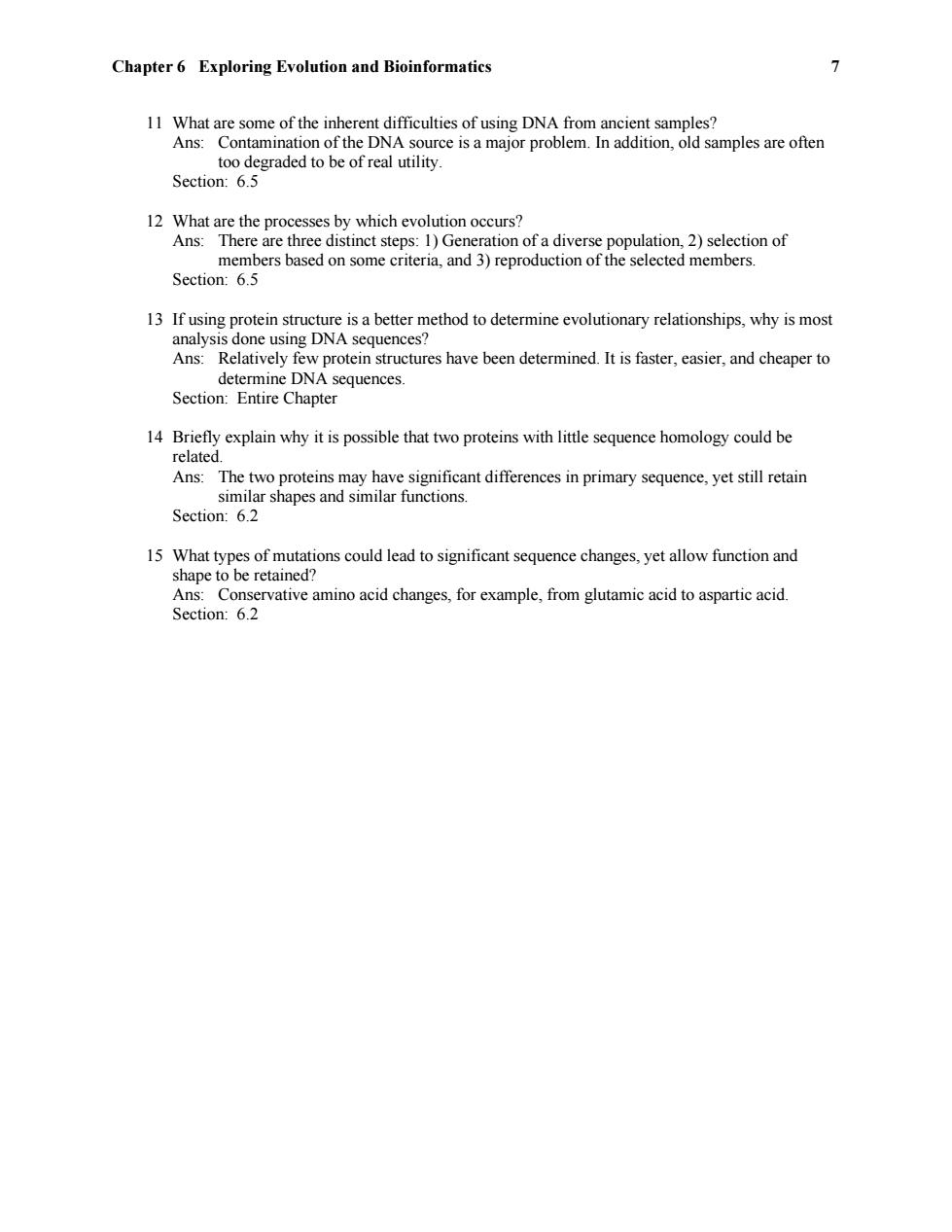
Chapter 6 Exploring Evolution and Bioinformatics 7 11 What are some of the inherent difficulties of using DNA from ancient samples? Ans:Contamination of the DNA source is a major problem.In addition,old samples are often too degraded to be of real utility. Section:6.5 12 What are the processes by which evolution occurs? Ans:There are three distinct steps:1)Generation of a diverse population,2)selection of members based on some criteria,and 3)reproduction of the selected members. Section:6.5 13 If using protein structure is a better method to determine evolutionary relationships,why is most analysis done using DNA sequences? Ans:Relatively few protein structures have been determined.It is faster,easier,and cheaper to determine DNA sequences. Section:Entire Chapter 14 Briefly explain why it is possible that two proteins with little sequence homology could be related. Ans:The two proteins may have significant differences in primary sequence,yet still retain similar shapes and similar functions. Section:6.2 15 What types of mutations could lead to significant sequence changes,yet allow function and shape to be retained? Ans:Conservative amino acid changes,for example,from glutamic acid to aspartic acid. Section:6.2
Chapter 6 Exploring Evolution and Bioinformatics 7 11 What are some of the inherent difficulties of using DNA from ancient samples? Ans: Contamination of the DNA source is a major problem. In addition, old samples are often too degraded to be of real utility. Section: 6.5 12 What are the processes by which evolution occurs? Ans: There are three distinct steps: 1) Generation of a diverse population, 2) selection of members based on some criteria, and 3) reproduction of the selected members. Section: 6.5 13 If using protein structure is a better method to determine evolutionary relationships, why is most analysis done using DNA sequences? Ans: Relatively few protein structures have been determined. It is faster, easier, and cheaper to determine DNA sequences. Section: Entire Chapter 14 Briefly explain why it is possible that two proteins with little sequence homology could be related. Ans: The two proteins may have significant differences in primary sequence, yet still retain similar shapes and similar functions. Section: 6.2 15 What types of mutations could lead to significant sequence changes, yet allow function and shape to be retained? Ans: Conservative amino acid changes, for example, from glutamic acid to aspartic acid. Section: 6.2